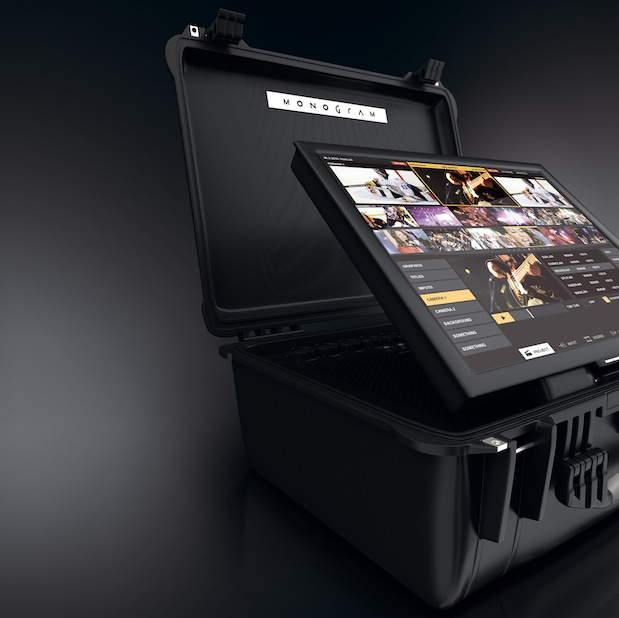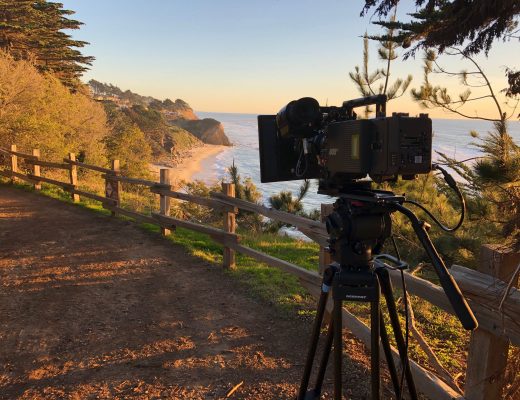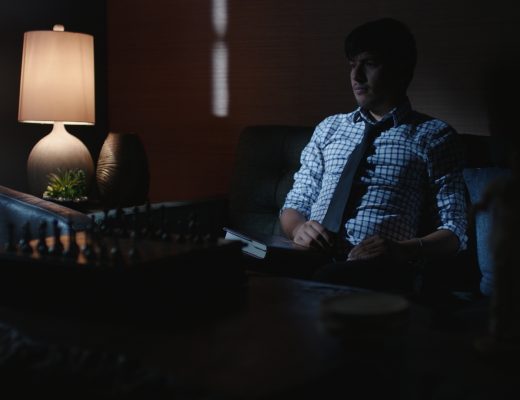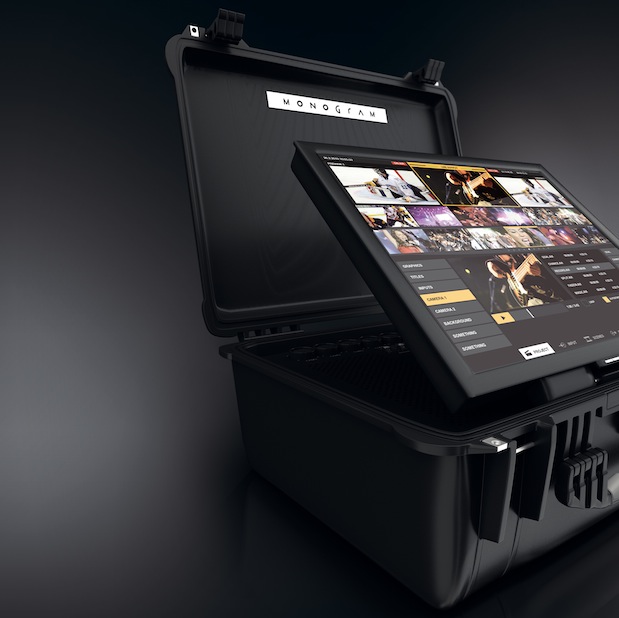
When people first hear about MONOGRAM’s BCC (Broadcast Case) production TV studio in a box, some of them mistakenly assume that it is a copycat of existing portable TV studio systems that have been on the market for a while. However, as soon as they get closer or hear more about it, they realize that it is quite the contrary. I had never seen a touch-screen interface before on a vision mixer (“switcher”), let alone for an entire portable production studio with onboard audio mixer, character generator, 4:2:2 recorder, and H.264 video streamer. I had also never heard of one with an onboard intercom system, yet alone one that could even power the cameras over a unique combined camera cable, which unifies SDI (or HD-SDI), power, intercom, and even tally information in one very manageable enclosure. In this article, you’ll learn how unique and groundbreaking the BCC really is.
BCC’s main features and benefits
- 4 or 8 input SDI or HD-SDI physical video inputs, with embedded audio capability and onboard scaling to match a project’s resolution
- Unlimited Internet inputs (i.e. Skype) with embedded audio capability and onboard scaling
- 2 XLR-balanced audio inputs, line level
- Inboard power supplies for cameras
- Inboard intercom system
- Inboard tally light system. Tally lights are included for cameras.
- Unique unified cable system for cameras (SDI/HD-SDI, power, intercom, tally)
- Inboard i-frame, 8-bit, 4:2:2 MPEG2 high-profile recorder with user-adjustable bit rate (default is 60Mb/s)
- Inboard H.264 web streamer with user-adjustable bit rate
- SDI/HD-SDI output for live broadcast or external 10-bit recording
- Touch-screen interface (more ahead)
- DVI-output for program monitor (not required)
- Unique template-based source system
- Optional HDMI input/output
- Optional instant replay with slow motion (recorded from all live camera inputs)
- Optional ISO recording of each camera source
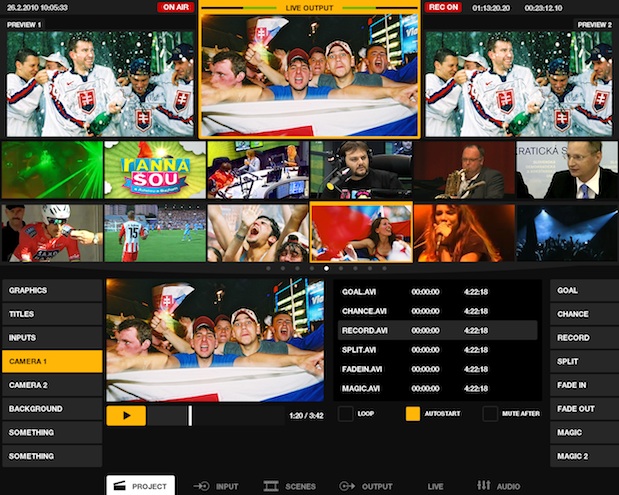
BCC’s live touch screen interface.
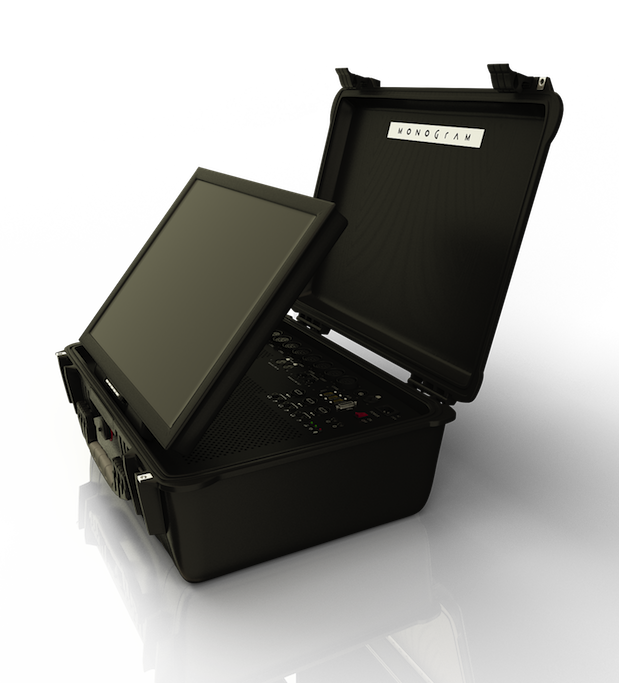
Side view of the BCC, revealing the connector panel.

BCC’s connector panel, inside the case, shown above with optional HDMI input/output.
BCC’s base pricing
Currently the BCC is available in the following base configurations:
- Standard definition with 4 physical SDI inputs for US$14,995
- Standard definition with 8 physical SDI inputs for US$17,995
- High definition with 4 physical SDI/HD-SDI inputs for US$19,995
- High definition with 8 physical SDI/HD-SDI inputs for US$23,995
- 3DHD with 4 physical stereo HD-SDI inputs for US$34,995
All of these configurations have a built-in intercom system and multi-camera power supply, and come with the appropriate number of combined camera cables, which include intercom, SDI (or HD-SDI), power, and tally lights, for the number of inputs ordered. Standard, they also include intercom headsets for the number of inputs, plus one for the director. Additional camera cables and additional headsets (i.e. for the producer) are available as options.
When the purchaser is planning to use cameras which already have SDI or HD-SDI output, BCC comes with the standard camera interface boxes, which provide power, tally light connection, and intercom headset connection. When the purchaser is planning to use lower cost cameras with only HDMI output -i.e the Panasonic AG-HMC40, HMC41 (used for demonstration purposes with the BCC at NAB 2010), AG-HMC80 or HMC81– then the purchaser should order the upgrade to the expanded camera interface box, which also contains an HDMI>HD-SDI converter, for +US$795 each (upgrade price, at the time of the original purchase).
The physical inputs are independent from the virtual (i.e. Skype) inputs. In other words, a BCC with 4 local cameras connected via HD-SDI can also have one or more virtual inputs, for a total of 4 local cameras, and at least one more via Skype. If the Skype source’s spatial resolution does not match the project’s, the BCC will upscale the Skype source to be full frame.
Note that MONOGRAM also offers a non-portable version of the BCC called BOB, at much lower cost, which requires a desktop computer (not included), and does not use a touch-screen interface.
Multi-standard at no extra cost
Unlike some other systems where there is an artificial financial penalty for 50Hz compatibility, with BCC, all units are multi-standard. This means that you are free to choose 720p50, 720p59.94, 1080i50, or 1080i59.94 on a project basis, without paying extra. Obviously, your cameras should be able to match the framerate you choose.
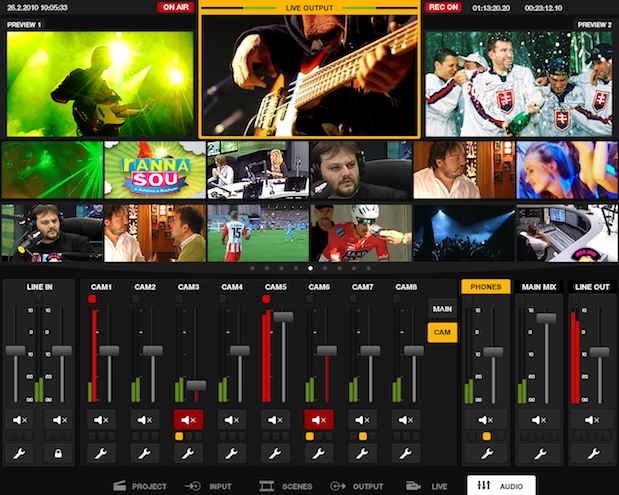
BCC’s onboard software-based audio mixer can accept embedded audio sources over HD-SDI, from remote Internet (i.e. Skype) sources, or from BCC’s pair of analog XLR inputs.
On page 2 of this article:
- Look Ma’, no physical keyboard required!
- Look Ma, no monitors required!
- BCC’s unique template-based source system
- BCC’s image editor, media library, scene editor
- BCC’s onboard chroma keyer
- BCC’s webstreaming adjustments
- BCC’s add-on options
- BCC’s internal components and specs
- Waveform monitor
- Warranty and distribution channel
- Inevitable competitive comparison
Click here for page 2 of this article.
Click here for page 2 of this article.
Look Ma’, no physical keyboard!
Thanks to the 19-inch diagonal touch screen which is hinged inside the BCC’s special Pelican case, no physical control panel, T-bar, or keyboard is required with the BCC. All user input to assign sources, change sources, or enter character generation text is all handled via the touch screen. However, for anyone who may insist on using them, the BCC has three USB ports which can allow their connection and use.
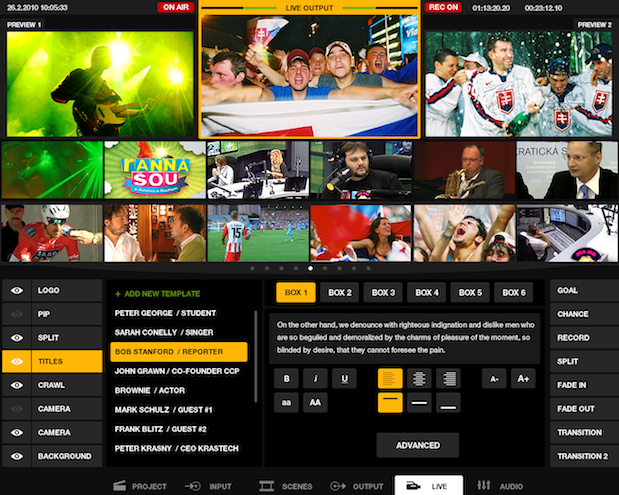
One of BCC’s character generator interface screen. Text may be entered via BCC’s on-screen virtual keyboard (as in the cases of the iPad/iPhone/Android) or optionally with a USB keyboard.
Look Ma’, no monitors required!
For the same reason mentioned above, there is no need to purchase, carry, connect, or use any external monitor to see sources or even program output. This is not only a reduction in cost, but also a major reduction in the “shlep” factor.
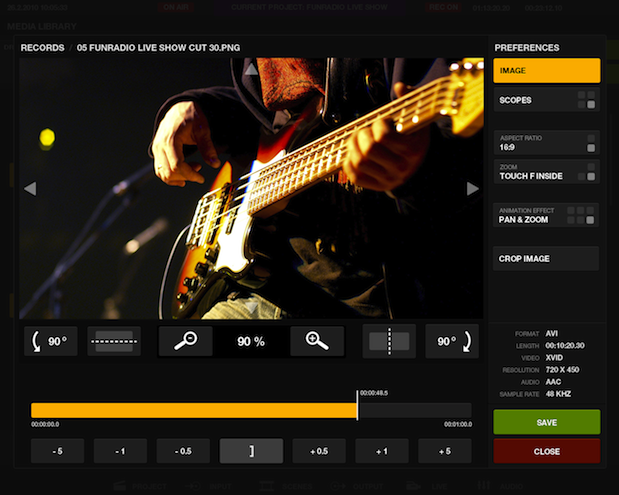
BCC’s image editor.
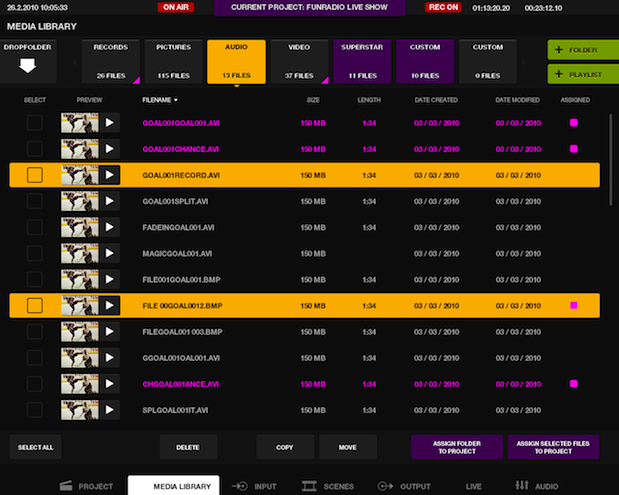
BCC’s media library.
BCC’s unique template-based source system
Although for experienced video producers, a minor mental reboot is required to discard the traditional video “switcher” methodology, once you absorb BCC’s template-based system, everything becomes more logical and more efficient. First of all, there is no longer the traditional row of numbered buttons for sources. Using the touch screen interface, your finger taps a visual source directly. Before a production, you create a project with all of the required sources. Rather than selecting a transition type during the production, you pre-program each source’s attributes, including its in-transition and (if appropriate, in the case of a pre-recorded video clip) the out-transition. Each one can be a cut, a dissolve of a any desired duration, or any digital effect transition. Each one can be with or without a lower third graphic, which also can be pre-programmed for its in-transition and out-transition. What if you want to go to camera 2, sometimes as a cut and other times as a 25-frame or 30-frame dissolve? No problem: Just create that as a source twice, one with each transition. Then, during the show, you tap whichever one you want at any particular time. After you digest the power of the template-based source system, together with the touch screen interface, you realize how more efficient and more pilot-error-free this system is compared with traditional ones.
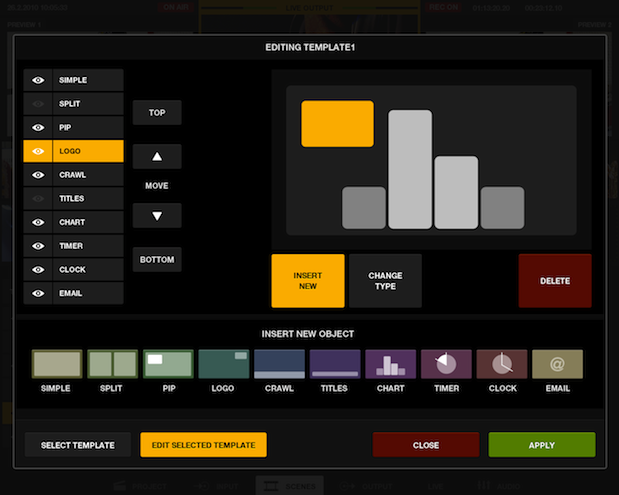
BCC’s scene editor.
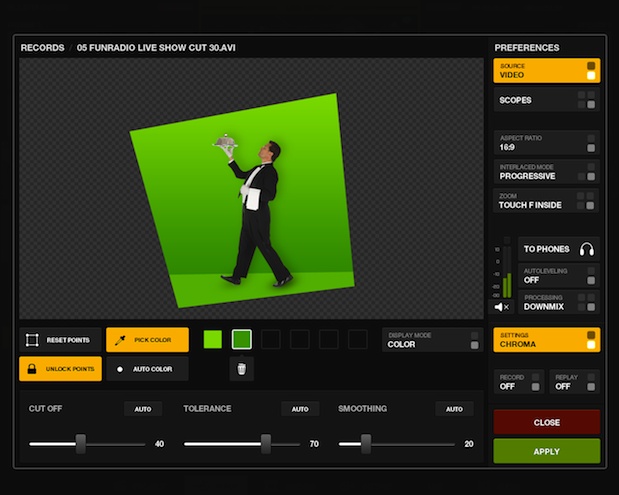
BCC’s onboard chroma keyer.
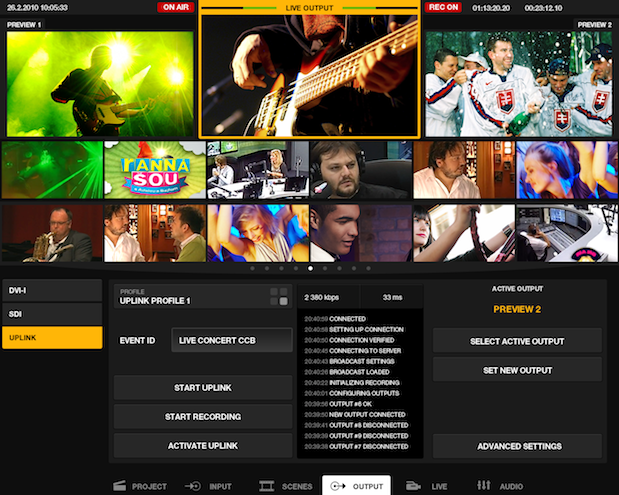
BCC’s webstreaming adjustments.
BCC’s add-on options
Optionally, you can add any of the following to a BCC:
- Instant replay with slow motion (recorded from all live camera inputs): US$4,995
- ISO recording, to have an independent recording of each source: US$7,885
- CG Design Packs, US$295
Internal components and specs
MONOGRAM informs me that the internal video processing in the BCC is 10-bit, 4:4:4, although the inboard recorder is 8-bit, 4:2:2 MPEG2 up to 60 Mb/s. The base system has in inboard i7 processor with Windows 7, 3GB RAM, and a 64GB SSD (solid state drive). Internal audio processing is 48khz stereo 16 bit.
If the ISO recording option is purchased, it comes with a 10,000 rpm SATA drive for recording, or two of them if the BCC is for 8-inputs. ISO recording is approximately three hours in HD for each camera.
BCC’s weight starts from 16kg (±35.2 pounds) and goes up to the maximum configuration weight at 24kg (±52.9 pounds).
Waveform monitor (my wish list)
The version of the latest BCC software shown at NAB was a ßeta version, and was temporarily missing the promised on-screen waveform monitor. I am hoping that when it appears, that it will offer the features and modes that I already published in my review on the NewTek TriCaster TCXD300, although adjusted for the BCC’s increased inputs:
I would like a Camera Setup mode “A”, where up to four waveform monitors (corresponding to the four camera inputs) are arranged side by side in such a way that they are occupying almost the entire raster to facilitate matching luma levels and black levels. To achieve the best S/N (signal-to-noise ratio), these adjustments are best made at the camera head, via a CCU or mini-CCU, but in case that’s not available, there should be access to the BCC’s proc-amp directly below each waveform monitor, to adjust black level and luma level. Camera Setup “B” would be the same thing, but show three huge vectorscopes side-by-side, with the proc-amp below each one, accessing the chroma saturation. Camera Setup “C” would be a huge waveform monitor (almost full raster) with each camera input signal superimposed over each other, but each one in a different color: perhaps red for input 1, green for input 2, blue for input 3, and amber, with the four appropriate proc-amp access windows below. Camera Setup “D” would be a huge vectorscope (almost full raster) but (unlike when viewing a single source on the vectorscope with the colors), it would have the same single color per channel as in mode “C”. I am still awaiting a screen shot to see how MONOGRAM will implement the waveform monitor and (possibly) the vectorscope.
Warranty and distribution channel
BCC’s manufacturer is in Slovakia in Europe. The worldwide distributor is Exwex. Readers in the Americas will be happy to know that they are implementing a manufacturing branch in Canada, and are very quickly signing up resellers throughout the Americas.
BCC comes with a 1-year standard warranty. A purchaser may prepay an additional 2-year warranty, which also includes a 96-hour replacement/new piece if something goes wrong, for US$4,995.
Inevitable competitive comparison
See the related article, BCC versus TriCaster TCXD300, together with my conclusions.
More info
More information: MonogramMultimedia.com
Allan T©pper’s articles, seminars, and audio programs
Get a full index of Allan T©pper’s articles and upcoming seminars and webinars at AllanTepper.com. Listen to his radio program TecnoTur, which is now available both in Castilian and in English, free of charge. Search for TecnoTur in iTunes or visit TecnoTur.us for more information.
Disclosure, to comply with the FTC’s rules
No manufacturer is paying Allan T©pper or TecnoTur LLC specifically to write this article. Some of the manufacturers listed above have contracted T©pper and/or TecnoTur LLC to carry out consulting and/or translations/localizations/transcreations. At the date of the publication of this article, none of the manufacturers listed above is/are sponsors of the TecnoTur programs, although all are welcome to do so, and some are, may be (or have been) sponsors of ProVideo Coalition magazine.

Filmtools
Filmmakers go-to destination for pre-production, production & post production equipment!
Shop Now